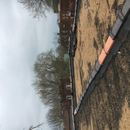Should I add new sheathing to a flat roof?
I own an old brick multi family building.
I am planning on getting five layers of an old built up roof torn off and replaced with 5” of polyISO and a TPO covering. Insulating from below is not an option right now.
Longevity and performance is always a top priority for me when getting a major repair done. Is it worthwhile to add an air barrier like zip sheathing on top of the roof deck before installing the new rigid foam and TPO?
Would an alternative like simply taping the joints of the old roof decking help create a good air barrier?
Any advice would be helpful, looking to do this right the first time and not have to worry about the roof for many decades.
GBA Detail Library
A collection of one thousand construction details organized by climate and house part











Replies
Hi Chris,
I'll give your post a bump. I suspect the experts will say you want the air barrier close to the thermal boundary.
What do you anticipate for an total R-value for your 5 inches of polyiso? R-30 maybe? Are you planning to add air permeable insulation under the roof sheathing as well?
Also... Are you using reclaimed foam? It's a lot cheaper than new stock.
Hi Steve,
Much appreciated! The r-value of the polyISO should be around R-30 maybe R-32. Have a few quotes pending for reclaimed polyISO, much cheaper! I may add rockwool insulation underneath at a later date as funds permit but as of now, the cavity between the upstairs ceiling and roof is uninsulated. (Building was built in 1907) Removing all the plaster and lathe in the ceilings and insulating from underneath would cost me almost as much as the new roof.
Could I get away with just taping the seams of the roof deck and adding a mechanically attached vapor barrier? Or is it wiser to add zip sheathing atop the roof deck?
Chris,
To your first two questions, yes. An air barrier underneath of the insulation is a good idea in all cases. The material and condition of the roof deck matters if you plan to tape the seams and penetrations to act as the air barrier. It's more likely that adding a membrane sealed at all penetrations and seams will be faster and equally as effective as zip sheathing.
Your climate zone matters in determining relative risk for condensation if you plan to add rockwool insulation underneath the deck, and also whether or not additional vapor control measures are needed beyond an air barrier. In most but not all cases an air barrier is sufficient.
https://www.buildingscience.com/documents/insights/bsi-019-uplifting-moments-roof-failures
Best,
j
Most retrofit guides show an air barrier bellow the foam:
https://www.buildingscience.com/file/5763
This makes sense as you don't want interior air to make it between the seams of the foam and condense on the roof membrane. How best to do that is up to you. I generally go with full peel and stick under foam for small flat roofs. I like the fact that it acts as secondary roof in when the roof membrane inevitably fails.
Thank you all for your very helpful answers. I am glad I posted here. That 2015 ZEHR is exactly what I was looking for! Not sure if I’m going to attach treated plywood to my parapet walls just yet, wouldn’t that effect the freeze/thaw cycle of the brick parapets?
I’m in climate zone 4, but very close to 5.
Do you have any recommendations for peel and stick air barriers that you like to use?
Brick parapets are exposed to freeze thaw cycles regardless of your roof insulation, membrane detailing or the addition of plywood. Limiting exposure to bulk water reduces freeze thaw risk.
Adding insulation to the inside of the walls is a different story.. If you ever plan to do that, the parapets can give you a sense of the freeze/thaw resistance inherent in the brick itself, especially if they run a few feet above the roof and are more exposed.
Go with whatever is available locally. For me it tends to be Henry/Grace/Soprema. Anything without a granular surface will work.
P.S. Make sure they install the foam in layers with staggered seams. This reduces the heat loss through the gaps in the foam as they tend to shrink over time.